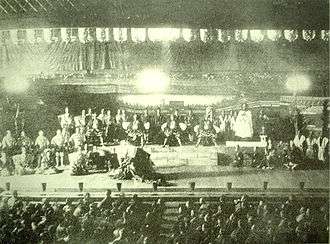Kabuki
Kabuki (歌舞伎) is a classical Japanese dance-drama. Kabuki theatre is known for the stylization of its drama and for the elaborate Kumadori (make-up) worn by some of its performers. Kabuki is considered to have begun in 1603 when Izumo no Okuni formed a female dance troupe to perform dances and light sketches in Kyoto, but developed into an all-male theatrical form after females were banned from kabuki theatre in 1629. This form of theatre was perfected in the late 17th and mid-18th century.
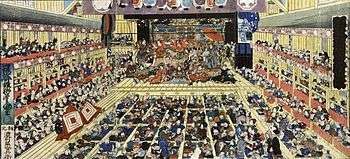
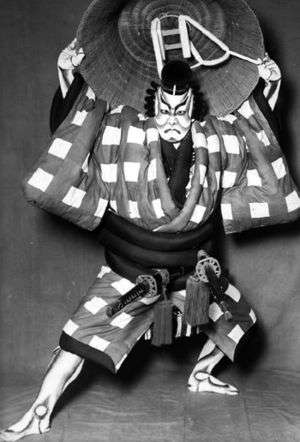
In 2005, the "Kabuki theatre" was proclaimed by UNESCO as an intangible heritage possessing outstanding universal value. In 2008, it was inscribed in the UNESCO Representative List of the Intangible Cultural Heritage of Humanity.[1]
Etymology
The individual kanji, from left to right, mean sing (歌), dance (舞), and skill (伎). Kabuki is therefore sometimes translated as "the art of singing and dancing". These are, however, ateji characters which do not reflect actual etymology. The kanji of 'skill' generally refers to a performer in kabuki theatre. Since the word Kabuki is believed to derive from the verb kabuku, meaning "to lean" or "to be out of the ordinary", Kabuki can be interpreted as "avant-garde" or "bizarre" theatre.[2] The expression kabukimono (歌舞伎者) referred originally to those who were bizarrely dressed. It is often translated into English as "strange things" or "the crazy ones", and referred to the style of dress worn by gangs of samurai.
History
1603–1629: Female kabuki
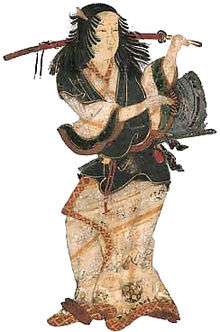
The history of kabuki began in 1603 when Izumo no Okuni, possibly a miko of Izumo-taisha, began performing with a troupe of female dancers a new style of dance drama, on a makeshift stage in the dry bed of the Kamo River in Kyoto.[3] It originated in the 17th century.[4] Japan was under the control of the Tokugawa shogunate, enforced by Tokugawa Ieyasu.[5] The name of the Edo period derives from the relocation of the Tokugawa regime from its former home in Kyoto to the city of Edo, present-day Tokyo. Female performers played both men and women in comic playlets about ordinary life. The style was immediately popular, and Okuni was asked to perform before the Imperial Court. In the wake of such success, rival troupes quickly formed, and kabuki was born as ensemble dance and drama performed by women—a form very different from its modern incarnation. Much of its appeal in this era was due to the ribald, suggestive themes featured by many troupes; this appeal was further augmented by the fact that the performers were often also available for prostitution.[2] For this reason, kabuki was also called "遊女歌舞妓" (prostitute-singing and dancing performer) during this period.
Kabuki became a common form of entertainment in the ukiyo, or Yoshiwara,[6] the registered red-light district in Edo. A diverse crowd gathered under one roof, something that happened nowhere else in the city. Kabuki theaters were a place to see and be seen as they featured the latest fashion trends and current events. The stage provided good entertainment with exciting new music, patterns, clothing, and famous actors. Performances went from morning until sunset. The teahouses surrounding or connected to the theater provided meals, refreshments, and good company. The area around the theatres was filled with shops selling kabuki souvenirs. Kabuki, in a sense, initiated pop culture in Japan.
The shogunate was never partial to kabuki and all the mischief it brought, particularly the variety of the social classes which mixed at kabuki performances. Women's kabuki, called onna-kabuki, was banned in 1629 for being too erotic.[7] Following onna-kabuki, young boys performed in wakashū-kabuki, but since they too were eligible for prostitution, the shōgun government soon banned wakashū-kabuki as well.[7] Kabuki switched to adult male actors, called yaro-kabuki, in the mid-1600s.[8] Male actors played both female and male characters. The theatre remained popular, and remained a focus of urban lifestyle until modern times. Although kabuki was performed all over ukiyo and other portions for the country, the Nakamura-za, Ichimura-za and Kawarazaki-za theatres became the top theatres in ukiyo, where some of the most successful kabuki performances were and still are held.[5]
1629–1673: Transition to yarō-kabuki
The modern all-male kabuki, known as yarō-kabuki (young man kabuki), was established during these decades. After women were banned from performing, cross-dressed male actors, known as onnagata ("female-role") or oyama, took over. Young (adolescent) men were preferred for women's roles due to their less masculine appearance and the higher pitch of their voices compared to adult men. In addition, wakashū (adolescent male) roles, played by young men often selected for attractiveness, became common, and were often presented in an erotic context.[9] Along with the change in the performer's gender came a change in the emphasis of the performance: increased stress was placed on drama rather than dance. Performances were equally ribald, and the male actors too were available for prostitution (to both female and male customers). Audiences frequently became rowdy, and brawls occasionally broke out, sometimes over the favors of a particularly handsome young actor, leading the shogunate to ban first onnagata and then wakashū roles. Both bans were rescinded by 1652.[10]
1673–1841: Golden age
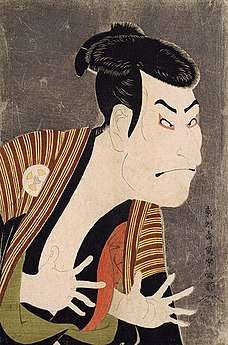

During the Genroku era, kabuki thrived. The structure of a kabuki play was formalized during this period, as were many elements of style. Conventional character types were established. Kabuki theater and ningyō jōruri, the elaborate form of puppet theater that later came to be known as bunraku, became closely associated with each other, and each has since influenced the other's development. The famous playwright Chikamatsu Monzaemon, one of the first professional kabuki playwrights, produced several influential works, though the piece usually acknowledged as his most significant, Sonezaki Shinjū (The Love Suicides at Sonezaki), was originally written for bunraku. Like many bunraku plays, it was adapted for kabuki, and it spawned many imitators—in fact, it and similar plays reportedly caused so many real-life "copycat" suicides that the government banned shinju mono (plays about lovers' double suicides) in 1723. Ichikawa Danjūrō I also lived during this time; he is credited with the development of mie[11] poses and mask-like kumadori make-up.[12]
1842–1868: Saruwaka-chō kabuki
Male actors played both female and male characters.[5]
_-85.282.6a-_Hokushu.jpg)
In the 1840s, fires started to affect Edo due to repeated drought. Kabuki theatres, traditionally made of wood, were constantly burning down, forcing their relocation within the ukiyo. When the area that housed the Nakamura-za was completely destroyed in 1841, the shōgun refused to allow the theatre to be rebuilt, saying that it was against fire code.[8] The shogunate did not welcome the mixing and trading that occurred between town merchants and actors, artists, and prostitutes. The shogunate took advantage of the fire crisis in 1842 to force the Nakamura-za, Ichimura-za, and Kawarazaki-za out of the city limits and into Asakusa, a northern suburb of Edo. Actors, stagehands, and others associated with the performances were forced out as well. Those in areas and lifestyles centered around the theatres also migrated, but the inconvenience of the new location reduced attendance.[5] These factors, along with strict regulations, pushed much of kabuki "underground" in Edo, with performances changing locations to avoid the authorities.
The theatres' new location was called Saruwaka-chō, or Saruwaka-machi. The last thirty years of the Tokugawa shogunate's rule is often referred to as the Saruwaka-machi period. This period produced some of the gaudiest kabuki in Japanese history.[5] The Saruwaka-machi became the new theatre district for the Nakamura-za, Ichimura-za and Kawarazaki-za theatres. The district was located on the main street of Asakusa, which ran through the middle of the small city. The street was renamed after Saruwaka Kanzaburo, who initiated Edo kabuki in the Nakamura Theatre in 1624.[5]
European artists began noticing Japanese theatrical performances and artwork, and many artists (for example, Claude Monet) were inspired by Japanese wood block prints. This Western interest prompted Japanese artists to increase their depictions of daily life including theatres, brothels, main streets and so on. One artist in particular, Utagawa Hiroshige, did a series of prints based on Saruwaka from the Saruwaka-machi period in Asakusa.[5]
The relocation diminished the tradition's most abundant inspiration for costuming, make-up, and story line. Ichikawa Kodanji IV was one of the most active and successful actors during the Saruwaka-machi period. Deemed unattractive, he mainly performed buyō, or dancing, in dramas written by Kawatake Mokuami, who also wrote during the Meiji era to follow.[5] Kawatake Mokuami commonly wrote plays that depicted the common lives of the people of Edo. He introduced shichigo-cho (seven-and-five syllable meter) dialogue and music such as kiyomoto.[5] His kabuki performances became quite popular once the Saruwaka-machi period ended and theatre returned to Edo; many of his works are still performed.
In 1868, the Tokugawa shogunate fell apart. Emperor Meiji was restored to power and moved from Kyoto to the new capital of Edo, or Tokyo, beginning the Meiji period.[8] Kabuki returned to the ukiyo of Edo. Kabuki became more radical in the Meiji period, and modern styles emerged. New playwrights created new genres and twists on traditional stories.
After the Meiji era
Beginning in 1868 enormous cultural changes, such as the fall of the Tokugawa shogunate, the elimination of the samurai class, and the opening of Japan to the West, helped to spark kabuki's re-emergence. As the culture struggled to adapt to the influx of foreign ideas and influence, actors strove to increase the reputation of kabuki among the upper classes and to adapt the traditional styles to modern tastes. They ultimately proved successful in this regard—on 21 April 1887, Emperor Meiji sponsored a performance.[13]
After World War II, the occupying forces briefly banned kabuki, which had strongly supported Japan's war since 1931;[14] however, by 1947 the ban had been rescinded.[15]
Today
The immediate post–World War II era was a difficult time for kabuki. Besides the war's physical devastation, many rejected the styles and thoughts of the past, kabuki among them.[16] Director Tetsuji Takechi's popular and innovative productions of kabuki classics at this time are credited with bringing about a rebirth of interest in kabuki in the Kansai region.[17] Of the many popular young stars who performed with the Takechi Kabuki, Nakamura Ganjiro III (b. 1931) was the leading figure. He was first known as Nakamura Senjaku, and this period in Osaka kabuki became known as the "Age of Senjaku" in his honor.[17]
Today, kabuki is the most popular of the traditional styles of Japanese drama—and its star actors often appear in television or film roles.[18] For example, the well-known onnagata Bandō Tamasaburō V has appeared in several (non-kabuki) plays and movies, often in a female role. Kabuki appears in works of Japanese popular culture such as anime. In addition to the handful of major theatres in Tokyo and Kyoto, there are many smaller theatres in Osaka and throughout the countryside.[19] The Ōshika Kabuki troupe,[20] based in Ōshika, Nagano Prefecture, is one example.[21]
Some local kabuki troupes today use female actors in onnagata roles. The Ichikawa Shōjo Kabuki Gekidan, an all-female troupe, debuted in 1953 to significant acclaim but failed to start a new trend.[22]
The introduction of earphone guides in 1975,[23] including an English version in 1982,[23] helped broaden the art's appeal. As a result, in 1991 the Kabuki-za, one of Tokyo's best known kabuki theaters, began year-round performances[23] and, in 2005, began marketing kabuki cinema films.[24] Kabuki troupes regularly tour Asia,[25] Europe[26] and America,[27] and there have been several kabuki-themed productions of canonical Western plays such as those of Shakespeare. Western playwrights and novelists have experimented with kabuki themes, an example of which is Gerald Vizenor's Hiroshima Bugi (2004). Writer Yukio Mishima pioneered and popularized the use of kabuki in modern settings and revived other traditional arts, such as Noh, adapting them to modern contexts. There have even been kabuki troupes established in countries outside Japan. For instance, in Australia, the Za Kabuki troupe at the Australian National University has performed a kabuki drama each year since 1976,[28] the longest regular kabuki performance outside Japan.[29]
In November 2002 a statue was erected in honor of kabuki's founder Okuni and to commemorate 400 years of kabuki's existence.[30] Diagonally across from the Minami-za,[31] the last remaining kabuki theater in Kyoto,[31] it stands at the east end of a bridge (Shijō Ōhashi)[31] crossing the Kamo River in Kyoto.
Kabuki was inscribed on the UNESCO Intangible Cultural Heritage Lists in 2005.[32][33]
Elements
Stage design
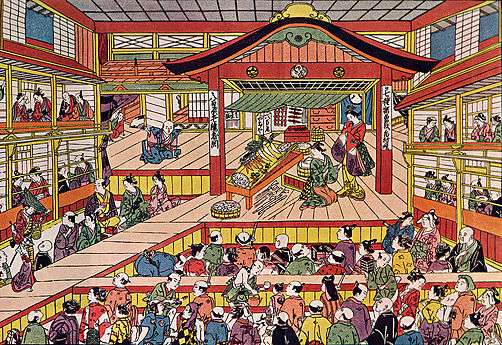
The kabuki stage features a projection called a hanamichi (花道, "flower path"), a walkway which extends into the audience and via which dramatic entrances and exits are made. Okuni also performed on a hanamichi stage with her entourage. The stage is used not only as a walkway or path to get to and from the main stage, but important scenes are also played on the stage. Kabuki stages and theaters have steadily become more technologically sophisticated, and innovations including revolving stages and trap doors were introduced during the 18th century. A driving force has been the desire to manifest one frequent theme of kabuki theater, that of the sudden, dramatic revelation or transformation.[34] A number of stage tricks, including actors' rapid appearance and disappearance, employ these innovations. The term keren (外連), often translated playing to the gallery, is sometimes used as a catch-all for these tricks. Hanamichi and several innovations including revolving stage, seri and chunori have all contributed to kabuki play. Hanamichi creates depth and both seri and chunori provide a vertical dimension.
Mawari-butai (revolving stage) developed in the Kyōhō era (1716–1735). The trick was originally accomplished by the on-stage pushing of a round, wheeled platform. Later a circular platform was embedded in the stage with wheels beneath it facilitating movement. The kuraten ("darkened revolve") technique involves lowering the stage lights during this transition. More commonly the lights are left on for akaten ("lighted revolve"), sometimes simultaneously performing the transitioning scenes for dramatic effect. This stage was first built in Japan in the early eighteenth century.
Seri refers to the stage "traps" that have been commonly employed in kabuki since the middle of the 18th century. These traps raise and lower actors or sets to the stage. Seridashi or seriage refers to trap(s) moving upward and serisage or serioroshi to traps descending. This technique is often used to lift an entire scene at once.
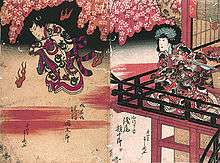
Chūnori (riding in mid-air) is a technique, which appeared toward the middle of the 19th century, by which an actor's costume is attached to wires and he is made to "fly" over the stage or certain parts of the auditorium. This is similar to the wire trick in the stage musical Peter Pan, in which Peter launches himself into the air. It is still one of the most popular keren (visual tricks) in kabuki today; major kabuki theaters, such as the National Theatre, Kabuki-za and Minami-za, are all equipped with chūnori installations.[35]
Scenery changes are sometimes made mid-scene, while the actors remain on stage and the curtain stays open. This is sometimes accomplished by using a Hiki Dōgu, or small wagon stage. This technique originated at the beginning of the 18th century, where scenery or actors move on or off stage on a wheeled platform. Also common are stagehands rushing onto the stage adding and removing props, backdrops and other scenery; these kuroko (黒子) are always dressed entirely in black and are traditionally considered invisible. Stagehands also assist in a variety of quick costume changes known as hayagawari (quick change technique). When a character's true nature is suddenly revealed, the devices of hikinuki and bukkaeri are often used. This involves layering one costume over another and having a stagehand pull the outer one off in front of the audience.
The curtain that shields the stage before the performance and during the breaks is in the traditional colours of black, red and green, in various order, or white instead of green, vertical stripes. The curtain consists of one piece and is pulled back to one side by a staff member by hand.
An additional outer curtain called doncho was not introduced until the Meiji era following the introduction of western influence. These are more ornate in their appearance and are woven. They depict the season in which the performance is taking place, often designed by renowned Nihonga artists.[36]
Performance
The three main categories of kabuki play are jidaimono (時代物, historical, or pre-Sengoku period stories), sewamono (世話物, domestic, or post-Sengoku stories) and shosagoto (所作事, dance pieces).[37]
Jidaimono, or history plays, are set within the context of major events in Japanese history. Strict censorship laws during the Edo period prohibited the representation of contemporary events and particularly prohibited criticising the shogunate or casting it in a bad light, although enforcement varied greatly over the years. Many shows were set in the context of the Genpei War of the 1180s, the Nanboku-chō Wars of the 1330s, or other historical events. Frustrating the censors, many shows used these historical settings as metaphors for contemporary events. Kanadehon Chūshingura, one of the most famous plays in the kabuki repertoire, serves as an excellent example; it is ostensibly set in the 1330s, though it actually depicts the contemporary (18th century) affair of the revenge of the 47 rōnin.
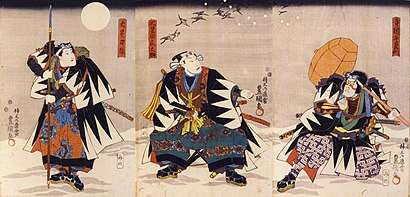
Unlike jidaimono which generally focused upon the samurai class, sewamono focused primarily upon commoners, namely townspeople and peasants. Often referred to as "domestic plays" in English, sewamono generally related to themes of family drama and romance. Some of the most famous sewamono are the love suicide plays, adapted from works by the bunraku playwright Chikamatsu; these center on romantic couples who cannot be together in life due to various circumstances and who therefore decide to be together in death instead. Many if not most sewamono contain significant elements of this theme of societal pressures and limitations.
Shosagoto pieces place their emphasis on dance, which may be performed with or without dialogue, where dance can be used to convey emotion, character and plot.[38] Quick costume change techniques may sometimes be employed in such pieces. Notable examples include Musume Dōjōji and Renjishi. Nagauta musicians may be seated in rows on stepped platforms behind the dancers.[39]
Important elements of kabuki include the mie (見得), in which the actor holds a picturesque pose to establish his character.[34] At this point his house name (yagō, 屋号) is sometimes heard in loud shout (kakegoe, 掛け声) from an expert audience member, serving both to express and enhance the audience's appreciation of the actor's achievement. An even greater compliment can be paid by shouting the name of the actor's father.
The main actor has to convey a wide variety of emotions between a fallen, drunkard person and someone who in reality is quite different since he is only faking his weakness, for example in the character of Yuranosuke in Chūshingura. This is called hara-gei or "belly acting", which means he has to perform from within to change characters. It is technically difficult to perform and takes a long time to learn, but once mastered the audience takes up on the actor's emotion.
Emotions are also expressed through the colours of the costumes, a key element in kabuki. Gaudy and strong colours can convey foolish or joyful emotions, whereas severe or muted colours convey seriousness and focus.
Keshō, kabuki makeup, provides an element of style easily recognizable even by those unfamiliar with the art form. Rice powder is used to create the white oshiroi base for the characteristic stage makeup, and kumadori enhances or exaggerates facial lines to produce dramatic animal or supernatural masks. The color of the kumadori is an expression of the character's nature: red lines are used to indicate passion, heroism, righteousness, and other positive traits; blue or black, villainy, jealousy, and other negative traits; green, the supernatural; and purple, nobility.[12]
Play structure
Kabuki, like other traditional forms of drama in Japan and other cultures, was (and sometimes still is) performed in full-day programs. Rather than attending for 2–5 hours, as one might do in a modern Western-style theater, audiences "escape" from the day-to-day world, devoting a full day to entertainment. Though some individual plays, particularly the historical jidaimono, might last an entire day, most were shorter and sequenced with other plays in order to produce a full-day program.
The structure of the full-day program, like the structure of the plays themselves, was derived largely from the conventions of bunraku and Noh, conventions which also appear in other traditional Japanese arts. Chief among these is the concept of jo-ha-kyū (序破急), which states that dramatic pacing should start slow, speed up, and end quickly. The concept, elaborated on at length by master Noh playwright Zeami, governs not only the actions of the actors, but also the structure of the play as well as the structure of scenes and plays within a day-long program.
Nearly every full-length play occupies five acts. The first corresponds to jo, an auspicious and slow opening which introduces the audience to the characters and the plot. The next three acts correspond to ha, speeding events up, culminating almost always in a great moment of drama or tragedy in the third act and possibly a battle in the second or fourth acts. The final act, corresponding to kyu, is almost always short, providing a quick and satisfying conclusion.[40]

While many plays were originally written for kabuki, many others were taken from jōruri plays, Noh plays, folklore, or other performing traditions such as the oral tradition of the Tale of the Heike. While jōruri plays tend to have serious, emotionally dramatic, and organized plots, plays written specifically for kabuki generally have looser, sillier plots.[41] One of the crucial differences in the philosophy of the two forms is that jōruri focuses primarily on the story and on the chanter who recites it, while kabuki focuses more on the actors. A jōruri play may sacrifice the details of sets, puppets, or action in favor of the chanter, while kabuki is known to sacrifice drama and even the plot to highlight an actor's talents. It was not uncommon in kabuki to insert or remove individual scenes from a day's schedule in order to cater to the talents or desires of an individual actor—scenes he was famed for, or that featured him, would be inserted into a program without regard to plot continuity.[41]
Kabuki traditions in Edo and in Kamigata (the Kyoto-Osaka region) were quite different. Through most of the Edo period, kabuki in Edo was defined by extravagance and bombast, as exemplified by stark makeup patterns, flashy costumes, fancy keren (stage tricks), and bold mie (poses). Kamigata kabuki, meanwhile, was much calmer and focused on naturalism and realism in acting. Only towards the end of the Edo period in the 19th century did the two regions adopt one another's styles to any significant degree.[42] For a long time, actors from one region often failed to adjust to the styles of the other region and were unsuccessful in their performance tours of that region.
Famous plays
- Kanadehon Chūshingura (Treasury of Loyal Retainers) is the famous story of the Forty-seven rōnin, led by Oishi Kuranosuke, who track down their enemy and exact revenge upon him before committing seppuku as required by their code of honor upon the death of their lord, Lord Takuminokami of the Asano clan.[43]
- Yoshitsune Senbon Zakura (Yoshitsune and the Thousand Cherry Trees) follows Minamoto no Yoshitsune as he flees from agents of his brother Yoritomo. Three Taira clan generals supposed killed in the Genpei War figure prominently, as their deaths ensure a complete end to the war and the arrival of peace, as does a kitsune named Genkurō.[44]
- Sugawara Denju Tenarai Kagami (Sugawara and the Secrets of Calligraphy) is based on the life of famed scholar Sugawara no Michizane (845–903), who is exiled from Kyoto, and upon his death causes a number of calamities in the capital. He is then deified, as Tenjin, kami (divine spirit) of scholarship, and worshipped in order to propitiate his angry spirit.[43]
Actors
Actors form schools or are associated with a particular theatre. Every actor has a stage name, which is different from the name they were born with. These stagenames, most often those of the actor's father, grandfather, or teacher, are passed down between generations of actors' lineages, and hold great honor and importance. Many names are associated with certain roles or acting styles, and the new possessor of each name must live up to these expectations; there is the feeling almost of the actor not only taking a name, but embodying the spirit, style, or skill of each actor to previously hold that name. Many actors will go through at least three names over the course of their career.
The shūmei (襲名, lit. name succession) are grand naming ceremonies held in Kabuki theatre in front of the audience. Most often, a number of actors will participate in a single ceremony, taking on new stage-names. Their participation in a shūmei represents their passage into a new chapter of their performing careers.
Major theatres in operation

See also
- Theatre of Japan
- Kanteiryū, a lettering style invented to advertise Kabuki and other theatrical performances
- Kyōgen, a traditional form of Japanese comic theatre that influenced the development of Kabuki
- Oshiguma, an imprint of the face make-up of kabuki actors, as artwork and souvenir
- Noh, a traditional form of Japanese theatre
- Bunraku, a traditional Japanese puppet theatre from whose scripts many Kabuki plays were adapted
- Kabuki actor lines, such as
- Sgt. Kabukiman NYPD, a 1991 comedic superhero film directed by Lloyd Kaufman and Michael Herz and distributed by Troma Entertainment.
- Kabukibu!, a light novel, manga, and anime series about a boy who loves Kabuki
- Kathakali
- Jingju
- Yakshagana
- Balinese dance
Notes
- https://ich.unesco.org/en/RL/kabuki-theatre-00163
- "Kabuki" in Frederic, Louis (2002). Japan Encyclopedia. Cambridge, Massachusetts: Harvard University Press.
- "Okuni | Kabuki dancer". Encyclopedia Britannica. Retrieved 5 May 2019.
- Haar 1971, p. 83
- Masato 2007
- Flynn, Patricia. "Visions of People: The Influences of Japanese Prints Ukiyo-e Upon Late Nineteenth and Early Twentieth Century French Art". Yale-New Haven Teachers Institute. Retrieved 9 April 2015.
- Lombard, Frank Alanson (1928). An Outline History of the Japanese Drama. London: George Allen & Unwin LTD. pp. 287–295. ISBN 978-1-138-91983-9.
- Ernst 1956, pp. 10–12
- Leupp 1997, pp. 91–92
- Leupp 1997, p. 92
- "Mie". Kabuki Jiten. Retrieved 9 February 2007.
- Kincaid, Zoe (1925). Kabuki: The Popular Stage of Japan. London: MacMillan and Co. pp21–22.
- Shōriya, Asagoro. Kabuki Chronology of the 19th century at Kabuki21.com (Retrieved 18 December 2006.)
- Brandon 2009
- Takemae, Eiji (2002) [1983]. The Allied Occupation of Japan. Robert Ricketts and Sebastian Swann (translators and adapters). New York & London: Continuum. pp. 390–391. ISBN 0-8264-6247-2.
- Kominz, Laurence (1997). The Stars Who Created Kabuki; Their Lives, Loves and Legacy. Tokyo, New York, London: Kodansha International. p. 232. ISBN 4-7700-1868-1.
- Toita, Yasuji (1970). "Zenshin-za Innovations". Kabuki: The Popular Theater. Performing Arts of Japan: II. Don Kenny (trans.). New York & Tokyo: Walker/Weatherhill. p. 213. ISBN 0-8027-2424-8.
- Shōriya, Asagoro. Contemporary Actors at Kabuki21.com. (Retrieved 18 December 2006.)
- "Kabuki Theaters". Kabuki21.com. 31 December 2013. Retrieved 25 July 2014.
- Japanese: 大鹿歌舞伎
- "Ōshika Kabuki". Retrieved 22 February 2007.
- Edelson, Loren. Playing for the Majors and the Minors: Ichikawa Girls' Kabuki on the Postwar Stage. In: Leiter, Samuel (ed). Rising from the Flames: The Rebirth of Theater in Occupied Japan, 1945–1952. Rowman & Littlefield, 2009. pp. 75–85.
- Martin, Alex, "Kabuki going strong, 400 years on", Japan Times, 28 December 2010, p. 3,
- Martin, Alex, "Kabuki going strong, 400 years on", Japan Times, 28 December 2010, p. 3, retrieved on 29 December 2010.
- "Kabuki Tours in Asia". Kabuki21.com. Retrieved 25 July 2014.
- "Kabuki Tours in Europe". Kabuki21.com. Retrieved 25 July 2014.
- "Kabuki Tours in North And South America". Kabuki21.com. Retrieved 25 July 2014.
- Za Kabuki Troupe, "Za Kabuki 2012: Who We Are." Last modified 2012. Accessed 28 April 2013. https://sites.google.com/site/zakabuki2010/who-we-are
- Negishi, K, and M Tomoeda. "ANU Za Kabuki." Monsoon, 2010, 26.
- Sign (in English) for Izumo no Okuni's statue in Kyoto
- Lonely Planet Kyoto, 2012, page 169
- "2001~2100". Kabuki21.com. Retrieved 25 July 2014.
- "UNESCO Culture Sector – Intangible Heritage – 2003 Convention :". Unesco.org. Retrieved 25 July 2014.
- Scott 1955, pp. 55–56
- Ukon Ichikawa as Genkurō Kitsune flying over audience Archived 10 January 2010 at the Wayback Machine in the July 2005 National Theatre production of Yoshitsune Senbon Zakura.
- "Archived copy". Archived from the original on 8 December 2015. Retrieved 27 November 2015.CS1 maint: archived copy as title (link)
- "Kabuki « MIT Global Shakespeares". Retrieved 8 April 2015.
- Pronko, Leonard C. Samuel L. Leiter (ed.). A Kabuki Reader: History and Performance: History and Performance. p. 248. ISBN 9781315706832.
- Leiter, Samuel L. Historical Dictionary of Japanese Traditional Theatre. p. 115. ISBN 9780810865143.
- Quinn, Shelley Fenno. "How to write a Noh play—Zeami's Sandō. Monumenta Nipponica, vol 48, issue 1 (Spring 1993). pp53–88.
- Toita, Yasuji (1970). Kabuki: The Popular Theater. New York: Weatherhill. pp 6–8.
- Thornbury, Barbara E. "Sukeroku's Double Identity: The Dramatic Structure of Edo Kabuki". Japanese Studies 6 (1982). Ann Arbor: Center for Japanese Studies, University of Michigan. 13
- Miyake, Shutarō (1971). "Kabuki Drama". Tokyo: Japan Travel Bureau. This story is one of the most popular traditional tales in Japan, and is based on a famous episode in 18th-century Japanese history.
- Jones, Stanleigh H. Jr. (trans.)(1993). "Yoshitsune and the Thousand Cherry Trees." New York: Columbia University Press.
References
- Brandon, James R. (2009). Kabuki's Forgotten War: 1931–1945. University of Hawaii Press. ISBN 0-8248-3200-0.CS1 maint: ref=harv (link)
- Ronald Cavaye (1993). Kabuki: A Pocket Guide. USA and Japan: Charles E. Tuttle,
- Ronald Cavaye, Paul Griffith and Akihiko Senda (2004). A Guide to the Japanese Stage. Japan: Kodansha International.
- Ernst, E. (1956). The Kabuki Theatre. New York: Oxford University Press.CS1 maint: ref=harv (link)
- Scott, A. C. (1955). The Kabuki Theatre of Japan. London: George Allen & Unwin Ltd.CS1 maint: ref=harv (link)
- Senelick, L. (2000). The Changing Room: Sex, Drag, and Theatre. London: Routledge.
- Facts JPN-kabuki. 25 November 2007 <https://web.archive.org/web/20070606160340/http://inic.utexas.edu/asnic/countries/japan/kabuki.html>.
- Japanese Culture. 25 November 2007 <http://japan-zone.com/culture/kabuki.shtml>.
- Kabuki. 25 November 2007 <http://japan-guide.com/e/e2090.html>
- Kabuki. Ed. Shoriya Aragoro. 9 September 1999. 25 November 2007 <http://www.kabuki21.com/>
- Haar, Francils (1971). Japanese Theatre in Highlight: A Pictorial Commentary. Westport: Greenwood P. p. 83.CS1 maint: ref=harv (link)
- Masato, Takaba (2007). "History of Kabuki: Birth of Saruwaka-machi". Watanabe Norihiko. Archived from the original on 20 January 2013. Retrieved 30 April 2009.CS1 maint: ref=harv (link)
- Leupp, Gary P. (1997). Male Colors: The Construction of Homosexuality in Tokugawa Japan. University of California Press. ISBN 0-520-20900-1.CS1 maint: ref=harv (link)
Further reading
- Kawatake, Toshio (2006). Kabuki: Baroque Fusion of the Arts. Tokyo: I-House Press.
- Matsui, Kesako (2016). Kabuki, a Mirror of Japan: Ten Plays that Offer a Glimpse into Evolving Sensibilities. Tokyo: Japan Publishing Industry Foundation for Culture.
External links
| Wikimedia Commons has media related to Kabuki. |
| Wikimedia Commons has media related to Kabuki actors. |
| Wikimedia Commons has media related to Kabuki theaters. |
- Kabuki Web—Shochiku Official Kabuki Website in English
- Earphone Guide—The English language Earphone Guide
- Kabuki 21—All about Japan's traditional Theatre Art of Kabuki: The art, the plays, the great stars of today, the legends of the past, the theaters, the history, the glossary, the traditions, the heroes and the derivatives.
- National Diet Library: photograph of Kabuki-za in Kyobashi-ku, Kobiki-cho, Tokyo (1900); Kakuki-za (1901); Kakuki-za (1909); Kabuki-za (1911); Kabuki-za (1912); Kakuki-za (1915)
- Kabuki prints by Utagawa Kuniyoshi (1798–1861)
- Japan Mint: Kabuki Coin Set
- Audio recording of the kabuki play Narukami by Ichikawa Danjūrō I at LostPlays.com
- 1969 'Camera Three' program on Kabuki, (audio only; with Faubion Bowers et al.)
